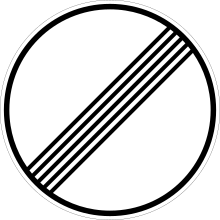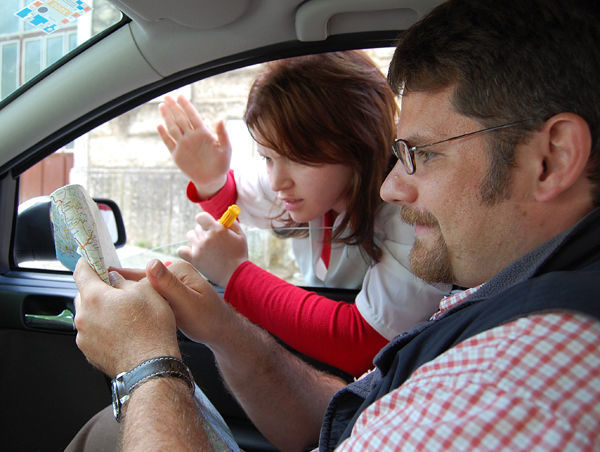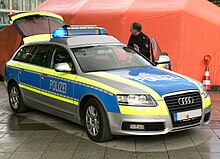
|
|
|
|||||||||||||||||||||||||||||||||||||||||||||||||||||||||||||||||||||||||||
German-built Reichsautobahnen in other countriesThe first autobahn in Austria was the West Autobahn from Wals near Salzburg to Vienna. Building started by command of Adolf Hitler shortly after the Anschluss in 1938. It extended the Reichsautobahn 26 from Munich (the present-day A8), however only 16.8 km (10.4 mi) including the branch-off of the planned Tauern Autobahn was opened to the public on 13 September 1941. Construction works discontinued the next year and were not resumed until 1955. There are sections of the former German Reichsautobahn system in the former eastern territories of Germany, i.e. East Prussia, Farther Pomerania and Silesia; these territories became parts of Poland and the Soviet Union with the implementation of the Oder–Neisse line after World War II. Parts of the planned autobahn from Berlin to Königsberg (the Berlinka) were completed as far as Stettin (Szczecin) on 27 September 1936. After the war, they were incorporated as the A6 autostrada of the Polish motorway network. A single-carriageway section of the Berlinka east of the former "Polish Corridor" and the Free City of Danzig opened in 1938; today it forms the Polish S22 expressway from Elbląg (Elbing) to the border with the Russian Kaliningrad Oblast, where it is continued by the R516 regional road. Also on 27 September 1936, a section from Breslau (Wrocław) to Liegnitz (Legnica) in Silesia was inaugurated, which today is part of the Polish A4 autostrada, followed by the (single vehicle) Reichsautobahn 9 from Bunzlau (Bolesławiec) to Sagan (Żagań) the next year, today part of the Polish A18 autostrada. After the German occupation of Czechoslovakia, plans for a motorway connecting Breslau with Vienna via Brno (Brünn) in the "Protectorate of Bohemia and Moravia" were carried out from 1939 until construction works discontinued in 1942. A section of the former Strecke 88 near Brno is today part of the R52 expressway of the Czech Republic. |
Safety
In 2014, autobahns carried 31% of motorized road traffic while accounting for 11% of Germany's traffic deaths. The autobahn fatality rate of 1.6 deaths per billion travel-kilometres compared favorably with the 4.6 rate on urban streets and 6.5 rate on rural roads.
Between 1970 and 2010, overall German road fatalities decreased by almost 80% from 19,193 to 3,648; over the same time period, autobahn deaths halved from 945 to 430 deaths. Statistics for 2013 show total German traffic deaths had declined to the lowest count ever recorded: 3,340 (428 on autobahns); a representative of the Federal Statistical Office attributed the general decline to harsh winter weather that delayed the start of the motorcycle-riding season. In 2014, there was a total of 3,377 road fatalities, while autobahn deaths dropped to 375.
| Road Class | Injury Crashes | Fatalities | Injury Rate* | Fatality Rate* | Fatalities per 1000 Injury Crashes |
|---|---|---|---|---|---|
| Autobahn | 18,901 | 375 | 0.082 | 1.6 | 19.8 |
| Urban | 209,618 | 983 | 1.052 | 4.9 | 4.7 |
| Rural | 73,916 | 2,019 | 0.238 | 6.5 | 27.3 |
| Total | 302,435 | 3,377 | 0.408 | 4.6 | 11.2 |
* per 1,000,000,000 travel-kilometres
In 2012, the leading cause of autobahn accidents was "excessive speed (for conditions)": 6,587 so-called "speed related" crashes claimed the lives of 179 people, which represents almost half (46.3%) of 387 autobahn fatalities that year. However, "excessive speed" does not mean that a speed limit has been exceeded, but that police determined at least one party travelled too fast for existing road or weather conditions. On autobahns 22 people died per 1,000 injury crashes; a lower rate than the 29 deaths per 1,000 injury accidents on conventional rural roads, which in turn is five times higher than the risk on urban roads—speeds are higher on rural roads and autobahns than urban roads, increasing the severity potential of a crash
Germany highways
|
|
Traffic laws and enforcementGerman police car (Bavaria, green)
German police car (Lower-Saxony, blue)
High Visibility German police car (Lower-Saxony, blue)
Driving in Germany is regulated by the Straßenverkehrs-Ordnung (road traffic regulations, abbreviated StVO). Enforcement on the federal Autobahnen is handled by each state's Highway Patrol (Autobahnpolizei), often using unmarked police cars and motorcycles and usually equipped with video cameras, thus allowing easier enforcement of laws such as tailgating. Notable laws include the following.
|
|
|
 |





















 Speed limits in Germany
Speed limits in Germany












